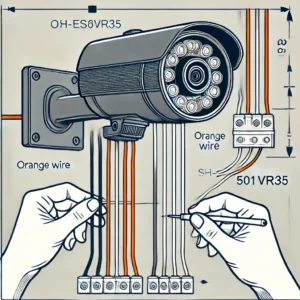SH-ES 501VR35 Security Camera Introduction
Made for both interior and outdoor security uses, the SH-ES501VR35 is a high-performance surveillance camera. Among its notable characteristics are:
Clear, crisp visuals are offered by high-definition video output.
Guarantees of night vision enable visibility in low-light or no-light environments.
Designed to resist strong environmental conditions is weather-resistant design.
If supported, audio recording records sound along with video.
Using these functionalities fully depends on proper wiring. Bad wiring could cause loss of audio, video, or other features.
Why correct wiring is important for security cameras?
The basis of every security camera system is wiring. It guarantees the camera gets the required voltage, hence regulating power supply.
✔️ Video Transmission: forwards the viewing or recording system the video stream to.
✔️ Audio Signal: (if relevant) sends camera microphone sound.
✔️ Control Functions: Certain cables handle PTZ (pan, tilt, zoom) capabilities.
Preventing failures and guaranteeing a flawless surveillance experience depend on knowing the particular purposes of the orange and white wires in the SH-ES501VR35 model.
Purposes of the Orange and White Wires in SH-ES501VR35
Every cable in a security camera fulfills a different function. The SH-ES 501VR35’s orange and white wires are absolutely essential.
Orange wire: video signal transmission
Usually responsible for sending video signals from the camera to the DVR (Digital Video Recorder) or NVR (Network Video Recorder), is the orange cable.
Should this cable be incorrectly connected, the image quality might suffer or the video stream may not show.
White wire: (if supported) audio signal transmission
Usually used for audio transmission, the white cable allows the camera to convey sounds to the recording system—should the model enable audio recording.
Not all security cameras enable audio; if your camera has a built-in microphone, the white cable must be suitably attached for good audio capture. To be sure the white wire is utilized for sound, consult the SH-ES 501 user handbook.
Detailed Guide on Linking the Orange and White Wires
1️⃣ Get Appropriate Tools
Make sure you have: ✅ wire strippers; ✅ electrical tape; ✅ multimeter for checking connection; ✅ user manual before beginning the setup.
2️⃣ Find the connecting points.
On your DVR/NVR or display monitor, locate the input terminals.
Name the audio and video inputs for the white and orange wires respectively.
Third: Strip the wire ends.
Remove a little portion of the insulation with wire strippers to expose the metal conductor within.
Fourth, connect the orange wire.
On the DVR/NVR, line the orange wire to the video input terminal.
Safe it correctly to prevent signal interference.
5️⃣ Connect the White Wire (if relevant)
Attach the white wire to the suitable audio input on the recording system if your camera supports audio.
Make sure the connection is strong to avoid distortions of sound.
6️⃣ Safe the Wiring
Fix connections using wire connectors or electrical tape.
Steer clear of leaving cables vulnerable to cause electrical shorts.
7️⃣ Test the System Power on the camera and confirm that, if relevant, the audio and video are operating as expected.
Common Wiring Issues Troubleshooting
Problems may develop even with careful installation. The following helps you solve the most often occurring issues:
🔸 Without a video signal?
✔️ Make sure the orange wire is tightly coupled to the proper video input.
✔️ Look over the wire for cuts or damage.
✔️ Try ruling out port failure by utilizing another video input port.
🔸 No audio signal?
✔️ Verify proper connection of the white wire to the audio input terminal.
✔️ See the manual of the camera to confirm audio support.
✔️ Change the DVR/NVR settings to permit audio recording.
😆 Weak or distorted signals?
✔️ See for wire continuity problems with a multimeter.
✔️ Make sure cables are not twisted or bent since this will compromise the signal quality.
✔️ Minimise interference by keeping power and signal lines apart.
Often asked questions ( FAQs)
1. In the SH-ES502VR35 camera, what does the orange wire serve for?
Transmission of video signals from the camera to the recording system is accomplished by the orange cable.
2. Could I leave the white wire unconnected?
Should your camera not support audio, there is no need for white wire connection. Still, it needs to be sufficiently fast locked to prevent electrical problems.
Should my camera not show video, what should I do?
✔️ Look over the orange cable connector.
✔️ Verify the DVR/NVR settings are set appropriately.
✔️ Look for loose connections or damage in the wiring.
4. How can I see whether my security camera cables are operational?
Verify power and signal transmissions and find continuity using a multimeter.
5. Does the SH-ES501VR35 camera allow for audio recording?
Look over the manufacturer’s handbook. Should support be granted, the white wire has to be coupled to an audio input source.
In summary,
Clear video and audio—if applicable—dependent on properly connecting the orange and white wires in your SH-ES 501VR35 security camera.
Following this tutorial will help you to: guarantee proper installation; understand the purpose of every wire; solve typical wiring problems.
Should you run across ongoing issues, go to the user handbook for the camera or call a professional installer.


